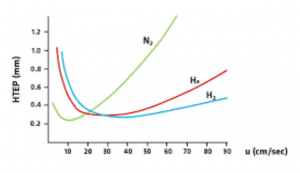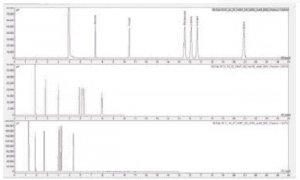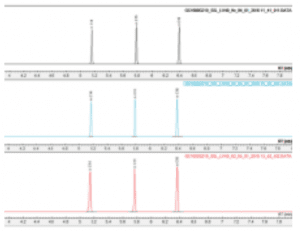The Use of Alternative Carrier Gases in Gas Chromatography
Carrier Gases Used In Gas Chromatography
Helium is one of the most common and lightest elements in the universe. The boiling point of helium is closer to absolute zero than any other element. When using helium consideration is rarely given to the fact that it is a non reusable element, meaning the world’s resources of helium are being depleted. Due to the limited availability and the increased sales prices of helium, alternative for helium must be implemented.
The importance of carrier gas selection has been a discussion point amongst users of gas chromatography for many years. To serve as a carrier gas in gas chromatography, the gases must be available in sufficient purity and inertness. There are three gases that are commonly used as a carrier gas: nitrogen, helium and hydrogen. The efficiency comparison between these gases is given by the Van Deemter curve which relates the efficiency with
carrier gas velocity through the column (speed). Figure 1 shows the Van Deemter curve for nitrogen, helium and hydrogen.

Fig 1. Van Deemter curve
The most efficient gas is hydrogen, followed by helium and nitrogen. Even though the optimum plate height for the three gases are almost identical, helium and nitrogen are behind with respect to analysis time. When viewing the Van Deemter curve, nitrogen has a narrow optimum, with both helium and hydrogen having wider optimums, meaning they may be used at higher velocities with only little sacrifice in separation efficiency.
Hydrogen is considered the optimal choice, combining high efficiency separations with short analysis times. However, hydrogen has a safety risk with a 4% concentration in air will lead to explosions.
To date, the worldwide carrier gas of choice has been the second most efficient gas; helium. However, with the rising cost and apparent shortage, the use of alternative carrier gases has increased over time.
Discussion
At SCION Instruments we take great care in designing analytical solutions, and as such in this note we will evaluate helium versus hydrogen and nitrogen as a carrier gas choice.
All analyses were carried out on a SCION 456 GC (The 8300 GC amd 8500 GC are the next generation 436 and 456 instruments, delivering the same excellent performance) equipped with split/splitless injector and FID. The chromatographic data has been recorded and evaluated in SCION’s Compass CDS data system. A standard BTEX mixture and a standard C14-C16 in isooctane mixture have been used as the samples for generating data.
Figure 2 summarises three runs of the BTEX mixture on a SCION-Wax column operated at 60°C isothermal. For nitrogen the chosen carrier velocity was at the optimum 13.5cm/s; for helium and hydrogen a velocity higher than the optimum was chosen, 37 and 53cm/s respectively.

Fig 2. Analysis of BTEX; top: nitrogen, middle: helium, bottom: hydrogen
Complete separation is obtained for all gases, but nitrogen takes three times the analysis time versus hydrogen, which are expected results based on the Van Deemter curve.
The risk in operating hydrogen may be reducing by employing a system which continuously monitors the hydrogen concentration inside the oven. At too high a concentration, the hydrogen supply to the column is stopped and switches to an inert gas, and pre-defined warnings are generated. This system allows safe use of hydrogen as carrier gas.
In many cases chromatographers will not only look to the application with respect to highest efficiency or shortest analysis time, but keeping the most practical solution in mind. Most applications will use temperature programming in order to reduce the analysis time. Figure 3 details three chromatograms of an alkane sample recorded with the three alternative carrier gasses, under identical operating conditions; 40cm/s and temperature ramping between 80°C and 200°C per minute.

Fig 3. Analysis of alkanes; top: helium, middle: hydrogen, bottom: nitrogen
Close examination of the peak-width reveals that helium and hydrogen are almost identical with nitrogen being 30% less efficient based on TZ values, which measure the number of baseline separated peaks between one pair of system homologues.
SCION is dedicated to helping users with their methods, and by showing that alternative carrier gases are a solution that we can advise upon. Apart from several instrumental options that help making savings and reduce risks, we can help with our level of knowledge in this area of gas chromatography.
Conclusion
From this study in which the use of alternative carrier gases were examined in more detail, the following may be concluded:
- With the use of alternative carrier gases, laboratories can reduce costs by moving to hydrogen, optimising speed of analysis without sacrificing resolving power
In future studies SCION will focus on the transfer of well accepted analytical solutions from helium to nitrogen. This will ensure that users will receive the instruments with lowest cost of ownership.
Download Application Note
Follow the link to download a PDF copy of this application note: ‘The Use of Alternative Carrier Gases in Gas Chromatography‘
More GC Carrier Gas Comparison Application Notes:
- Cannabis Potency by GC-FID with Carrier Gas Comparison (Helium, Hydrogen, Nitrogen)
- Plant Protection Products Active Ingredient Assay by GC-FID with Nitrogen Carrier Gas
Get In Touch
For more information about any of our products or services, or to discuss your specific requirement, please get in touch, and a member of our team will be happy to help.
